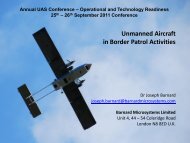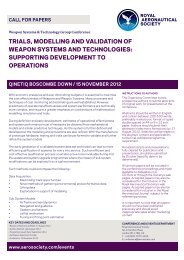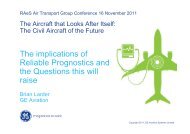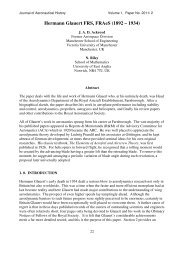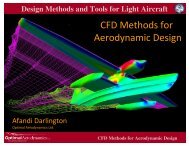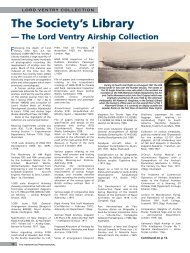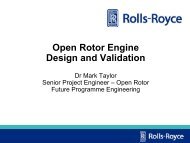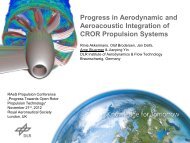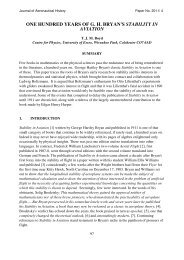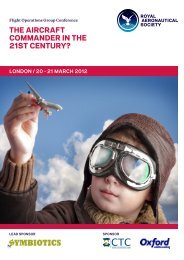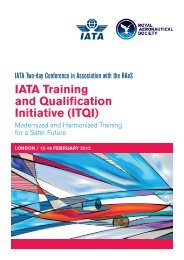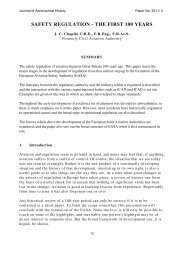Air to Air Refuelling in Civil Aviation, An Opportunity & A Vision Dr ...
Air to Air Refuelling in Civil Aviation, An Opportunity & A Vision Dr ...
Air to Air Refuelling in Civil Aviation, An Opportunity & A Vision Dr ...
You also want an ePaper? Increase the reach of your titles
YUMPU automatically turns print PDFs into web optimized ePapers that Google loves.
efficiencies drop off markedly. The high efficiency<br />
of the short range aircraft can be ma<strong>in</strong>ta<strong>in</strong>ed over<br />
the longer ranges us<strong>in</strong>g AAR.<br />
Reserve fuel policies vary between regula<strong>to</strong>ry<br />
bodies, domestic / International flights, airl<strong>in</strong>es and<br />
pilots. Pilots may opt for extra reserve fuel over and<br />
above that required by relevant regulations.<br />
Typical average values for X are 15000+ nm.<br />
The current trend is for ever-larger more<br />
powerful eng<strong>in</strong>es. Naturally, the emphasis is on<br />
<strong>in</strong>creas<strong>in</strong>g fuel efficiency for the larger units. Some<br />
of the favourable design developments can be<br />
scaled for smaller eng<strong>in</strong>es, fuel efficiencies are<br />
relatively less for the latter. Geared fans may help.<br />
The development of Prop fans may result <strong>in</strong><br />
quieter and more fuel-efficient power-plants. The<br />
effects on X values due <strong>to</strong> the result<strong>in</strong>g changes <strong>in</strong><br />
V and SFC need <strong>to</strong> be assessed.<br />
3. AIR-TO-AIR REFUELLING (AAR),<br />
CIVIL AIRCRAFT<br />
3.1. Compar<strong>in</strong>g 3000, 6000, 9000 & 12000 nm<br />
Range <strong>Air</strong>craft with and without AAR<br />
Based on Refs.8, 11 & 12, the approach is <strong>to</strong><br />
design representative aircraft <strong>to</strong> carry the same<br />
payload of 250 pax. over 3000, 6000, 9000 & 12000<br />
nm and then estimate the fuel saved by us<strong>in</strong>g the<br />
base 3000 nm range aircraft with AAR for the<br />
longer ranges. The base aircraft requires less than<br />
50,000 lbs of fuel per 3000 nm stage, dispensed<br />
fairly easily from current tankers, provided the<br />
operational tanker range is kept low. Each tanker<br />
may accomplish 3-4 operations <strong>in</strong> a mission.<br />
The relative sizes of the aircraft designed for 250<br />
passengers over the different ranges are compared<br />
<strong>in</strong> Fig.11. The fuselage size rema<strong>in</strong>s constant, the<br />
w<strong>in</strong>g area <strong>in</strong>creases rapidly <strong>to</strong> conta<strong>in</strong> fuel needed<br />
and <strong>to</strong> ma<strong>in</strong>ta<strong>in</strong> CL as design range <strong>in</strong>creases.<br />
The base aircraft weight variation over 3000 nm<br />
is shown <strong>in</strong> Fig. 12. The block fuel used <strong>to</strong> carry<br />
250 pax over this range is 46,147 lb (MTOW =<br />
261,932 lb). <strong>An</strong> aircraft designed <strong>to</strong> carry the same<br />
payload over 6000 nm, Fig. 13, uses 161,269 lb fuel<br />
(doubl<strong>in</strong>g the range has more than trebled the fuel<br />
required, MTOW = 505,438 lb). The <strong>in</strong>creased fuel,<br />
over and above that required for the doubled range,<br />
is needed for the additional aircraft weight. This<br />
arises from land<strong>in</strong>g gear / w<strong>in</strong>g structure required <strong>to</strong><br />
carry the additional fuel weight and provide the<br />
extra tank volume. Fig. 13 also compares the weight<br />
variations with range for the 6000 nm aircraft and<br />
the 3000 nm aircraft refuelled at 3000 nm. Note the<br />
fuel used and the sav<strong>in</strong>gs offered by AAR, 42%<br />
over 6000 nm (not <strong>in</strong>clud<strong>in</strong>g tanker fuel at this<br />
stage). This amounts <strong>to</strong> sav<strong>in</strong>g <strong>in</strong> fuel cost of nearly<br />
$190/pax (at $4.7/USG). With an allowance of<br />
tanker fuel, the comparable figure is about $175.<br />
Fig. 14 refers <strong>to</strong> the weight variations for 9000<br />
nm range (250 pax). <strong>An</strong> aircraft without a refuell<strong>in</strong>g<br />
option would have MTOW of 656,262 lb, and burn<br />
263,073 lb of fuel. With the 3000 nm aircraft and<br />
two AAR operations, the block fuel would be<br />
138,441 lb, a sav<strong>in</strong>g of 47% (without tanker fuel).<br />
This amounts <strong>to</strong> sav<strong>in</strong>g <strong>in</strong> fuel cost of nearly<br />
3<br />
$350/pax (at $4.7/USG). Allow<strong>in</strong>g for the tanker<br />
fuel, the comparable figure is about $320.<br />
3.2. Size. Cost & Noise Reductions Us<strong>in</strong>g Smaller<br />
<strong>Air</strong>craft<br />
Even with current technology levels, us<strong>in</strong>g the<br />
3000nm aircraft for all long ranges with AAR<br />
implies not just size reduction but also associated<br />
reductions <strong>in</strong> noise, cost, emissions, etc. We look<br />
briefly at aircraft siz<strong>in</strong>g, cost and noise trends.<br />
Fig.15 shows the span correlation aga<strong>in</strong>st<br />
MTOW for several current aircraft (www.Boe<strong>in</strong>g).<br />
Ideally, w<strong>in</strong>g Aspect Ratio and hence span should<br />
be as large as possible for aerodynamic benefits.<br />
For larger design payloads and ranges, the size and<br />
span are subject <strong>to</strong> physical / structural / airport gate<br />
limits (e,g. ICAO).<br />
Fig.16 shows the acquisition cost trend aga<strong>in</strong>st<br />
OEW (l<strong>in</strong>es C1 & C2 represent the lower and<br />
higher quoted costs). Fig.16 shows an approximate<br />
correlation aga<strong>in</strong>st range. Such trends reflect the<br />
economic situations (supply, demand, numbers built<br />
etc.) and may be somewhat hypothetical. Essentially<br />
large aircraft cost more.<br />
Fig 18 shows ICAO Stage 3 noise certification<br />
limits. Lighter aircraft have more str<strong>in</strong>gent noise<br />
requirements than heavier aircraft. In any case,<br />
smaller aircraft do tend <strong>to</strong> be quieter because of less<br />
<strong>in</strong>stalled thrust.<br />
By us<strong>in</strong>g smaller, 3000 nm range aircraft with<br />
AAR, the <strong>in</strong>creases <strong>in</strong> costs, noise and pollution<br />
associated with long-range flights can be avoided.<br />
3.3. Cruise Climb or Constant Altitude Flight<br />
It is useful <strong>to</strong> exam<strong>in</strong>e the cruise and altitude<br />
relationships with the different range aircraft.<br />
<strong>Air</strong>craft w<strong>in</strong>gs are optimised for cruise at a<br />
constant CL value of about 0.55. Assum<strong>in</strong>g start of<br />
cruise at 28,000 ft, if CL and M are held constant the<br />
3000nm aircraft would climb <strong>to</strong> 32,000ft dur<strong>in</strong>g the<br />
cruise phase. The 6000 nm aircraft climbs <strong>to</strong> about<br />
36,000ft and the 9000nm aircraft will reach<br />
39,000ft, see Fig.19.<br />
<strong>Air</strong> traffic control requires 2000 ft vertical<br />
separation between aircraft and consequently<br />
aircraft fly at constant stepped altitudes. Decreases<br />
<strong>in</strong> CL, (<strong>in</strong> spite of L/D reduction) are accompanied<br />
by a reduction <strong>in</strong> drag and thrust required. So the<br />
compromises are lessened.<br />
The long-range aircraft undergo the greatest<br />
change <strong>in</strong> altitude dur<strong>in</strong>g cruise. The fuselage has <strong>to</strong><br />
withstand an <strong>in</strong>creased pressure differential with<br />
obvious implications on stress, fatigue and <strong>in</strong>itial<br />
design weight. Short-range aircraft are naturally<br />
better balanced for altitude effects and these could<br />
be ma<strong>in</strong>ta<strong>in</strong>ed over long ranges with AAR.<br />
At constant CL, simple estimates <strong>in</strong>dicate a 2%<br />
degradation <strong>in</strong> L/D dur<strong>in</strong>g cruise for a 3000 nm<br />
range aircraft. For 6000 and 9000 nm range aircraft<br />
the degradation is of the order of 7% and 12%<br />
respectively. With 3000 nm aircraft and AAR on<br />
the long ranges, the L/D degradations can be small.<br />
With variable camber, constant CL need not be<br />
ma<strong>in</strong>ta<strong>in</strong>ed and altitude relationship become easier.<br />
3.4. Fuel Burn & Operat<strong>in</strong>g Costs Issues<br />
The variations of fuel burn and costs with design<br />
range are summarised <strong>in</strong> Fig.20. The projected fuel



